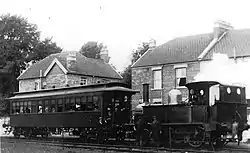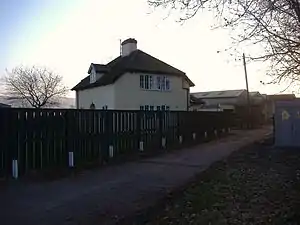Weston, Clevedon and Portishead Light Railway
The Weston, Clevedon and Portishead Light Railway (WC&PR) was a 13.8 miles (22.2 km) standard gauge light railway in Somerset, England. It was conceived as a tramway in the 1880s, opening between the coastal towns of Weston-super-Mare and Clevedon in 1897 and completed to Portishead in 1907. It closed in 1940.
 Hesperus at Weston-super-Mare with one of the 'American' coaches | |
| Overview | |
|---|---|
| Headquarters | Clevedon |
| Locale | England |
| Dates of operation | 1897–1940 |
| Technical | |
| Track gauge | 1,435 mm (4 ft 8 1⁄2 in) standard gauge |
| Length | 13.8 mi (22.2 km) |
History
Construction and opening
A broad gauge railway from Portishead to Clevedon was proposed in 1865 to connect with the Bristol and Portishead Railway which was then under construction. If it had been built it would have allowed direct services from Clevedon to Bristol which would have avoided the need to change at Yatton.[1]
A new proposal in 1884 envisaged the three towns being linked by a 'Weston-super-Mare, Clevedon and Portishead Tramway'. This standard gauge line would run along the street from the Boulevard to Ashcombe Road in Weston-super-Mare and then off-road (apart from numerous level crossings) from there to Portishead. An Act of Parliament authorising its construction was passed on 6 August 1885.[2][3]
Building of the Weston-super-Mare to Clevedon section of the tramway began in 1887 but progress was slow due to many legal and financial problems. The Act had stipulated that construction should be completed within 5 years but further Acts had to be passed on 25 July 1890 and again on 27 July 1892 to extend the time allowed. The section from Ashcombe Road to Clevedon was formally inspected by the Board of Trade on 26 August 1897 but not allowed to open. Due to the long time taken to build the line some of the wooden sleepers had rotted and needed to be replaced. The local council also complained about the state of the track along the streets in Weston-super-Mare so this section was taken up. A second inspection was made on 9 November and the line finally opened on 1 December 1897.[2] Instead of the extension to the Boulevard, the Tramway provided horse buses from Ashcombe Road to Birnbeck Pier and the Sanatorium for a few years.[4]
Completion to Portishead

The powers to construct the railway had run out in 1896 so another Act of Parliament was required. After some opposition from the Clevedon Urban District Council regarding the necessary level crossings, the Act was passed on 9 August 1899. In addition to allowing construction to be completed to Portishead by August 1904 it enabled the tramway to convert to a light railway with the name changed to the Weston, Clevedon and Portishead Light Railway Company.[5]
Financial difficulties continued. By 1904 the company was about £76,000 in debt so a new limited company was floated, the Weston, Clevedon and Portishead Docks Railway, with a capital of £120,000.[6] The new company still found it difficult to raise enough money until September 1905 when £14,500 of 5% debentures were taken up by the Excess Insurance Company. In 1906 it borrowed £16,000 from other sources but was unable to repay the interest so the Excess Insurance Company provided funds up to £15,000 in March 1907 on the condition that the existing directors were replaced by new directors chosen by the insurance company.[7]
With money available again work could be completed on the new line to Portishead. It was inspected on 31 July 1907 and opened for traffic on 7 August 1907.[8]
Receivership and closure
In 1909 Cuthbert Heath, the managing director of the Excess Insurance Company, petitioned for the railway to enter receivership. Spencer Gore-Browne, one of the directors nominated by the insurance company, was appointed as the receiver and Colonel Stephens, the so-called' 'Light Railway king' was appointed as manager in 1911. He managed the railway along with a number of similar lines from an office in Tonbridge, Kent.[9]
Stephens tried to gain additional business for the line. A small branch was opened at Wick St Lawrence to serve a wharf which the railway built on the River Yeo; the railway operated some boats carrying coal from Wales for a few years in the 1920s. Two additional passenger halts were opened in 1917-1918 and the larger stations given improved facilities. From 1921 a number of internal combustion railcars and rail-mounted tractors were used which significantly reduced costs. Steam locomotives were retained, especially for the trains from Clevedon to Portishead which conveyed heavy traffic from quarries in the area.[9]
Colonel Stephens died on 23 October 1931 and was replaced as manager by his former assistant W. H. Austen. Spencer Gore-Browne died in 1933 and Cuthbert Heath was running down his involvement as he approached retirement. Gore-Brown had been known to pay some charges out of his own pocket but the new owners and receiver were less kindly disposed to the railway. Receipts were reducing too, and from 1935 some of the traffic from Black Rock Quarry (the largest freight forwarder on the line) was transferred to road haulage.[9]
The company obtained a court order to close the line and the last train ran on 18 May 1940.[9] Shortly after this the Great Western Railway (GWR) purchased the line (but not the land) to use to store wagons loaded with coal that could not be delivered due to the war. The GWR inspected the line on 16 June 1940 but had difficulty in getting one of the Terrier class locomotives to work. They concluded that the bridge across the River Yeo could support a train of six wagons.[10] Some wagons were stored in various sidings at the Weston-super-Mare end of the line but were moved back across the river in case of bombing. The WC&PR rolling stock was all taken to Swindon Works in August 1940 but was scrapped except for two Terriers which were overhauled and retained by the GWR. Lifting the line started on 3 October 1942 from the Weston-super-Mare end using one of the Terriers. By the end of October the track had been lifted as far as Ebdon Lane. Between February and June 1943 the track was lifted between Portishead and the River Yeo but the remainder had to be removed by road. 16,000 tons of material was recovered.[11]
The company which owned the land no longer existed so it could not be sold off. The town councils at Weston-super-Mare and Clevedon wanted it for roads and houses so paid the £3,750 value of the land to the Bank of England.[11]
Description
Weston, Clevedon and Portishead Railway | ||||||||||||||||||||||||||||||||||||||||||||||||||||||||||||||||||||||||||||||||||||||||||||||||||||||||||||||||||||||||||||||||||||||||||||||||||||||||||||||||||||||||||||||||||||||||||||||||||||||||||||||||||||||||||||||||
|---|---|---|---|---|---|---|---|---|---|---|---|---|---|---|---|---|---|---|---|---|---|---|---|---|---|---|---|---|---|---|---|---|---|---|---|---|---|---|---|---|---|---|---|---|---|---|---|---|---|---|---|---|---|---|---|---|---|---|---|---|---|---|---|---|---|---|---|---|---|---|---|---|---|---|---|---|---|---|---|---|---|---|---|---|---|---|---|---|---|---|---|---|---|---|---|---|---|---|---|---|---|---|---|---|---|---|---|---|---|---|---|---|---|---|---|---|---|---|---|---|---|---|---|---|---|---|---|---|---|---|---|---|---|---|---|---|---|---|---|---|---|---|---|---|---|---|---|---|---|---|---|---|---|---|---|---|---|---|---|---|---|---|---|---|---|---|---|---|---|---|---|---|---|---|---|---|---|---|---|---|---|---|---|---|---|---|---|---|---|---|---|---|---|---|---|---|---|---|---|---|---|---|---|---|---|---|---|---|---|---|---|---|---|---|---|---|---|---|---|---|---|---|---|---|
| ||||||||||||||||||||||||||||||||||||||||||||||||||||||||||||||||||||||||||||||||||||||||||||||||||||||||||||||||||||||||||||||||||||||||||||||||||||||||||||||||||||||||||||||||||||||||||||||||||||||||||||||||||||||||||||||||
The railway ran through sparsely-populated and level countryside. It was 13.8 miles (22.2 km) long with 19 stations or halts, most of which had a small shelter and no platform. It was built with economy in mind and there were no major station buildings or bridges.
Links to the Great Western Railway were provided at Clevedon and Portishead. A short branch to a wharf at Wick St. Lawrence on the River Yeo was built in 1915. Sidings served three stone quarries in the Gordano Valley.
Rolling stock
Most of the locomotives and rolling stock were bought second-hand from various sources, making a varied collection.
Steam locomotives
| Number | Name | Type | Builder | Built | To WC&PR | Withdrawn | Former railway and notes[12] |
|---|---|---|---|---|---|---|---|
| — | Harold | 0-6-0ST | Kitson | 1872 | 1897 | 1898 | |
| — | Clevedon | 0-6-0T | Walker Brothers | ? | 1897 | 1898 | |
| — | Clevedon | 2-2-2WT | Sharp Stewart | 1857 | 1898 | 1904? | Furness Railway |
| — | Weston | 2-2-2WT | Sharp Stewart | 1866 | 1898 | 1906 | Furness Railway |
| — | Portishead | 0-6-0T | Robert Stephenson | 1887 | 1898 | 1901 | |
| 1 | Clevedon | 2-4-0T | Dübs | 1879 | 1901 | 1940 | Jersey Railway |
| — | Emlyn No. 82 | 0-6-0ST | Kitson | ? | 1903? | 1907 | |
| — | — | 2-4-0T | Sharp Stewart | 1872 | 1903 | 1906 | London, Brighton and South Coast Railway |
| — | Emlyn No. 96 | 0-6-0ST | Black, Hawthorn | ? | 1905? | 1905 | |
| 3 | Weston | 0-6-0ST | Manning Wardle | 1881 | 1906 | 1940 | |
| 2 | Portishead | 0-6-0ST | Manning Wardle | 1890 | 1907 | 1926 | |
| 4 | Walton Park | 0-6-0ST | Hudswell, Clarke | 1908 | 1908 | 1912 | WC&PR's first "new" locomotive |
| 4 | Hesperus | 2-4-0T | Sharp Stewart | 1876 | 1911 | 1937 | W&PRR/Great Western Railway[13] |
| 2 | Northiam | 2-4-0T | Hawthorn Lelsie | 1899 | 1917? | 1921 | On loan from Kent and East Sussex Railway |
| 5 | — | 0-6-0ST | Manning Wardle | 1919 | 1919 | 1940 | |
| 2 | Portihead | 0-6-0T | LBSCR | 1877 | 1925 | 1940 | LBSCR/Southern Railway |
| 4 | — | 0-6-0T | LBSCR | 1875 | 1937 | 1940 | LBSCR/Southern Railway |
The line today
Due to the lack of major infrastructure, there are few obvious remains of the line. Still surviving is a small bridge over a rhyne in Portishead, the remains of a bridge over the River Yeo, and the wharf. Much of the route of the track bed survives, a small part of which can be walked on Weston Moor reserve in the Gordano Valley. There are plans to convert some of the track bed to a cycle path as part of the National Cycle Network.
The WC&P Railway Group was formed in November 2006, to attempt to preserve what was left of the railway.
References
- Redwood, Christopher (1981). The Weston, Clevedon and Portishead Railway. Weston-super-Mare: Avon-Anglia. p. 17. ISBN 0-905466-42-X.
- Redwood 1981, pp. 22-35
- Maggs, Colin (1964). The Weston, Clevedon and Portishead Railway. Lingfield: The Oakwood Press. pp. 5–12.
- Strange, Peter (1989). The Weston, Clevedon & Portishead Railway, a pictorial record. Truro: Twelveheads Press. pp. 44–45. ISBN 0-906294-19-3.
- Redwood 1981, pp. 37-40
- Redwood 1981, p. 42
- Redwood 1981, pp. 49-53
- Redwood 1981, pp. 45-46
- Redwood 1981, pp. 53-75
- Bourne, John (1956). "The Weston, Clevedon & Portishead Railway". Trains Illustrated. Vol. 9 no. 8. pp. 393–399.
- Redwood 1981, pp. 163-165
- Strange 1989, p. 33
- Darbyshire, Les (1970). "W.C.&P.R. No. 4 Hesperus". Model Railway News. Vol. 46 no. 552. pp. 632–633.
- Strange 1989, pp. 29—30
- Clark, P.R. (1976). "Southern Railway petrol railcar No. 5". Model Railway Constructor. Vol. 43 no. 505. pp. 176–177.
External links
| Wikimedia Commons has media related to Weston, Clevedon and Portishead Railway. |
Further reading
- Mitchell,Vic and Smith, Keith (2003). Branch Lines to Clevedon and Portishead. Midhurst: Middleton Press. ISBN 1-904474-18-7.
- Scott-Morgan, John (1978). The Colonel Stephens Railways: A Pictorial Survey. Newton Abbot: David & Charles. ISBN 0 7153 7544 X.CS1 maint: ref=harv (link)
- Smith, Martin (1992). The Railways of Bristol & Somerset. Shepperton: Ian Allan. ISBN 0-7110-2063-9.